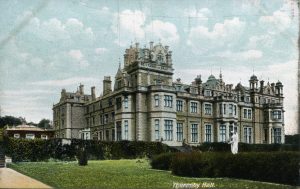
Thoresby is one of the 5 estates that became known as the Dukeries. The Pierrepont family originally came over with William I in 1066 with Holme Pierrepont becoming their residence at the end of the 13th century. In 1633, Robert Pierrepont, 1st Earl bought land in Perlethorpe and the Hays of Bilhaugh in Sherwood Forest from the Crown to form Thoresby Park.


A close up of original house. Designed by William Talman

The Hall was replaced by a much smaller house, built between 1767 and 1771 for the 2nd Duke. It was a red brick building with a pediment supported by Ionic columns on the main front. It was refurbished by Charles Pierrepont (later 1st Earl Manvers) after he succeeded to the estate in 1788, and the park was landscaped by Humphrey Repton. This house was demolished by the 3rd Earl in 1860 as its low situation next to the lake had often been criticised as unhealthy. Subsequently replaced by Anthony Salvin’s Victorian Gothic style built slightly uphill and in a more imposing position.
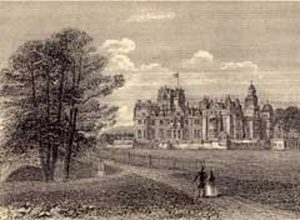
3rd Hall. Built for 3rd Earl Manvers in 1860.
 Thoresby Hall from the lake
Thoresby Hall from the lake
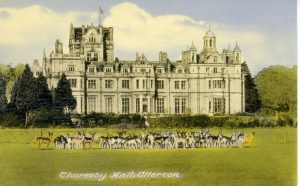 Thoresby Hall with deer
Thoresby Hall with deer
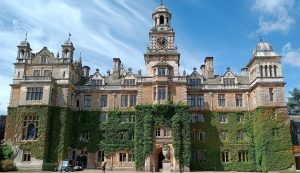 Thoresby Hall 2023
Thoresby Hall 2023
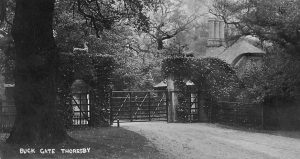 Buck Gate
Buck Gate
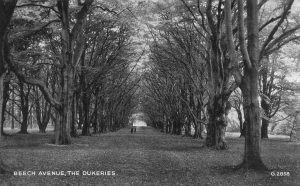
Beech Avenue
Meet the family
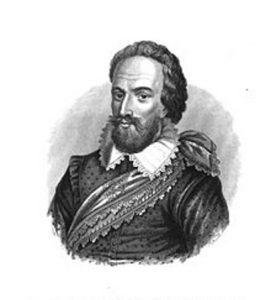 Robert Pierrepont 1st Earl of Kingston-upon-Hull. (1584-1643)
Robert Pierrepont 1st Earl of Kingston-upon-Hull. (1584-1643)
Robert Pierrepont, 1st Earl, acquired the Thoresby lands in 1633. His grandparents were William Cavendish and Elizabeth (Bess) of Hardwick. He remained neutral on the outbreak of the Civil War, declaring, in what was later taken to be a prophetic curse: “When… I take arms with the King against Parliament, or with the Parliament against the King, let a cannon-ball divide me between them”. He eventually became a Royalist, joining King Charles, and was appointed lieutenant-general of royal forces in the counties of Lincoln, Rutland, Huntingdon, Cambridge and Norfolk.
Whilst defending Gainsborough he was taken prisoner, and was killed on 25 July 1643, aged 58, while being conveyed to Hull by boat along the River Trent. Royalist forces fired at his captors from the river bank, accidentally killing the Earl whose body was cut in two by a cannonball.
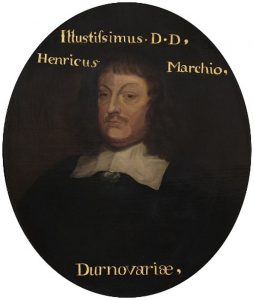
Henry Pierrepont, 2nd Earl of Kingston, & 1st Marquess of Dorchester, (1607– 1680)
The earl’s heir was his eldest son, Henry Pierrepont, 1st Marquess of Dorchester and 2nd Lord Dorchester, was a leading member of the Nottinghamshire Commission of Array in 1642, he raised money and troops for the Royalist cause. Following the King’s defeat he turned his attention to law and medicine. His collection of books is now part of the library of the Royal College of Physicians. After his death the Pierrepont family were based at Thoresby and used Holme Pierrepont as a second residence.
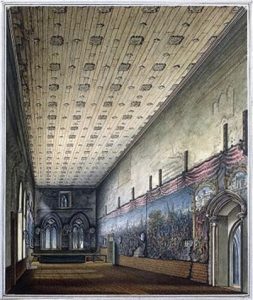 Painted chamber He was notorious for his bad temper and violent outbursts. In 1666, on a trivial pretext, he and George Villiers, 2nd Duke of Buckingham, came to blows in the Painted Chamber at Westminster during a Parliamentary conference. As a result, they were both imprisoned in the Tower of London for violating the dignity of Parliament, but they were soon released after apologising.
Painted chamber He was notorious for his bad temper and violent outbursts. In 1666, on a trivial pretext, he and George Villiers, 2nd Duke of Buckingham, came to blows in the Painted Chamber at Westminster during a Parliamentary conference. As a result, they were both imprisoned in the Tower of London for violating the dignity of Parliament, but they were soon released after apologising.
Dorchester survived his 2 sons and when he died in 1680 the Marquessate of Dorchester became extinct. The earldom was inherited by three great-nephews in turn, the third of whom became the 5th Earl of Kingston.
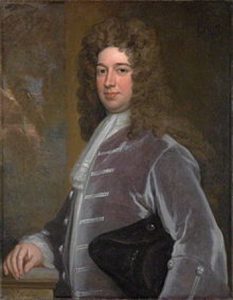 Evelyn Pierrepont, 1st Duke of Kingston-upon-Hull, & 5th Earl of Kingston (c.1665 – 1726)
Evelyn Pierrepont, 1st Duke of Kingston-upon-Hull, & 5th Earl of Kingston (c.1665 – 1726)
He had been the member of parliament for East Retford before his accession to the peerage as fifth Earl in 1690. While serving as one of the commissioners for the union with Scotland, he was created Marquess of Dorchester in 1706, and took a leading part in the business of the House of Lords. In 1715, he was created Duke of Kingston-upon-Hull, and was a prominent figure in the fashionable society of his day.
Portrait by Godfrey Kneller
Lady Mary Wortley Montagu (née Pierrepont) (1689 – 1762) a writer, & poet.
 His daughter, Lady Mary, spent her early life at Thoresby. By the time she was 16 she had written two volumes of poetry, a short novel, and taught herself Latin. In 1712, Lady Mary eloped to marry Edward Wortley Montagu, and they moved to London and made her name in the annals of both medicine and literature. She contracted smallpox in 1715 but recovered against expectations.
His daughter, Lady Mary, spent her early life at Thoresby. By the time she was 16 she had written two volumes of poetry, a short novel, and taught herself Latin. In 1712, Lady Mary eloped to marry Edward Wortley Montagu, and they moved to London and made her name in the annals of both medicine and literature. She contracted smallpox in 1715 but recovered against expectations.
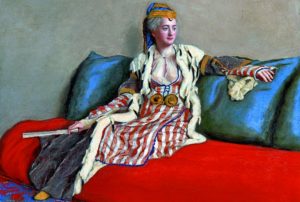 Lady Mary in Turkish dress. Acknowledgement to University of Liverpool
Lady Mary in Turkish dress. Acknowledgement to University of Liverpool
 In 1716, her husband was appointed Ambassador to the Ottoman empire and they moved to Constantinople, now known as Istanbul where she was to spend the next two years of her life. Lady Mary was pleased to discover inoculation against smallpox was widespread in the Ottoman empire, and like Dr Jenner fought to introduce smallpox immunisation into England against incredible prejudice. Mary’s brother, William, who died of smallpox, aged 20, married and had a son who became the 2nd Duke of Kingston.
In 1716, her husband was appointed Ambassador to the Ottoman empire and they moved to Constantinople, now known as Istanbul where she was to spend the next two years of her life. Lady Mary was pleased to discover inoculation against smallpox was widespread in the Ottoman empire, and like Dr Jenner fought to introduce smallpox immunisation into England against incredible prejudice. Mary’s brother, William, who died of smallpox, aged 20, married and had a son who became the 2nd Duke of Kingston.
Imperial Gate leading to courtyard, Topkapi Palace, Constantinople known as Sublime Porte until C18th.
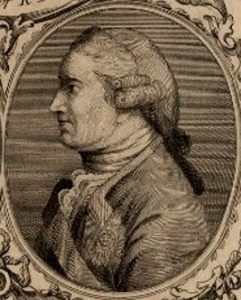 Pierrepont studied at Eton College and in 1726, went on the Grand Tour, spending ten years on the Continent and becoming known for gambling and loose living. Evelyn Pierrepont, 2nd Duke of Kingston-upon-Hull, succeeded his grandfather in 1726, inheriting the Thoresby estate in Nottinghamshire.
Pierrepont studied at Eton College and in 1726, went on the Grand Tour, spending ten years on the Continent and becoming known for gambling and loose living. Evelyn Pierrepont, 2nd Duke of Kingston-upon-Hull, succeeded his grandfather in 1726, inheriting the Thoresby estate in Nottinghamshire.
Evelyn Pierrepont, 2nd Duke of Kingston-upon-Hull, (1711 – 1773)

Details from Tillemans’ painting of 1725 showing Evelyn the 2nd Duke of Kingston hunting by Thoresby Lake on which his boats are visible.
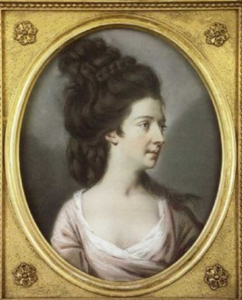 In 1736, he returned to England with his mistress, Marie-Thérèse de Fontaine de la Touche, who remained with him until 1750.
In 1736, he returned to England with his mistress, Marie-Thérèse de Fontaine de la Touche, who remained with him until 1750.
Madam la Touche.
Battle of Culloden.
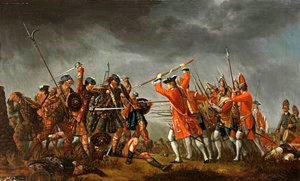
An Incident in the Rebellion of 1745, by David Morier
By 1745, his debts were four times his income. Politics was of scant interest to him, but he did hold several local offices, such as head ranger of Sherwood Forest, and master of the staghounds north of the Trent. When the Jacobite rising of 1745 broke out, though heavily in debt, he raised a regiment called “Kingston’s Light Horse,” which distinguished itself at the Battle of Culloden. Around 1750, he broke up with Marie-Therese and found a new mistress, Elizabeth Chudleigh. On 8 March 1769, Pierrepont married Elizabeth Hervey (nee Chudleigh), although their marriage was later judged to have been bigamous. He died in 1773 without issue, and his titles became extinct, leaving Chudleigh all his property, on condition she remain a widow. The duke’s nephews challenged the will on the grounds of bigamy and in 1776 Chudleigh was found guilty at a trial by her peers at Westminster Hall that attracted 4,000 spectators. However, this was found not to affect her inheritance, so she was able to retain the Pierrepont estates until her death, which took place in August 1788. at Saint-Assise near Paris. Thus, the Pierrepont estates passed to the Duke’s nephew, Charles Medows,
 Elizabeth Pierrepont, Duchess of Kingston and Countess of Bristol. Her father, Colonel Thomas Chudleigh, was lieutenant governor of the Royal Hospital, Chelsea. Elizabeth was a notorious society figure and had secretly married Augustus Hervey the future earl of Bristol in 1744. Both husband and wife lacked the financial support they needed, and their union was kept secret to enable Chudleigh to retain her post at court, while Hervey, a naval officer, rejoined his ship, returning to England toward the close of 1746. There seemed to be some doubt about the marriage’s validity and it was eventually declared unlawful by the courts. So, on 8 March 1769, Elizabeth was able to marry Evelyn. However, in 1775 her first husband’s brother died, and Hervey became Earl of Bristol. In 1777, he gained legal recognition that his marriage to Chudleigh had been lawful, but he did not pursue divorce proceedings, which meant that Elizabeth became Countess of Bristol.
Elizabeth Pierrepont, Duchess of Kingston and Countess of Bristol. Her father, Colonel Thomas Chudleigh, was lieutenant governor of the Royal Hospital, Chelsea. Elizabeth was a notorious society figure and had secretly married Augustus Hervey the future earl of Bristol in 1744. Both husband and wife lacked the financial support they needed, and their union was kept secret to enable Chudleigh to retain her post at court, while Hervey, a naval officer, rejoined his ship, returning to England toward the close of 1746. There seemed to be some doubt about the marriage’s validity and it was eventually declared unlawful by the courts. So, on 8 March 1769, Elizabeth was able to marry Evelyn. However, in 1775 her first husband’s brother died, and Hervey became Earl of Bristol. In 1777, he gained legal recognition that his marriage to Chudleigh had been lawful, but he did not pursue divorce proceedings, which meant that Elizabeth became Countess of Bristol.
Charles Philip Medows changed his name to Pierrepont in 1788 and, in 1806, he was created the first Earl Manvers. He joined the Royal Navy, commanding a number of vessels before retiring in 1769. He married and was succeeded by his second son Charles Herbert Pierrepont
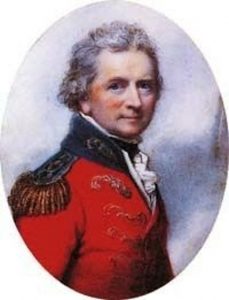
Charles (Medows) Pierrepont, 1st Earl Manvers
Charles Herbert Pierrepont, 2nd Earl. Charles served in the Royal Navy for 13 years, during which time he commanded 3 vessels, one of which was HMS Spartiate.. He served with Nelson in the Mediterranean during the Napoleonic Wars but retired on half pay in 1803 to concentrate on the management of his estates, and was regarded as a good landlord.

Charles Herbert Pierrepont, 2nd Earl Manvers (1778 – 1860)

One of the vessels captained by Charles. Spartiate leaving Rio de Janeiro in 1835, by Emeric Essex Vidal
St Mary’s Church School. Charles was responsible for building the school which opened in 1826 to children over 5 years of age. Now used as the Village Hall, and home to the Parish Council.

St Mary’s Church School Edwinstowe. Now used as Village Hall
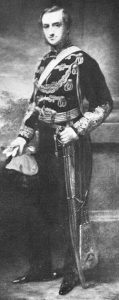 Sydney William Herbert Pierrepont (1825 – 1900) 3rd Earl Manvers, built the present Thoresby Hall.
Sydney William Herbert Pierrepont (1825 – 1900) 3rd Earl Manvers, built the present Thoresby Hall.
He was commissioned a first lieutenant in the Nottinghamshire Yeomanry Cavalry (Sherwood Rangers) in 1844. He was Member of Parliament for South Nottinghamshire and deputy lieutenant of Nottinghamshire until 1860, when he succeeded his father as Earl Manvers. He was appointed lieutenant-colonel commandant of the South Nottinghamshire Yeomanry Cavalry regiment in 1868, and honorary colonel in 1879. 3rd Earl Manvers, built the present Thoresby Hall, St John’s Church, Perlethorpe, and the School. He shaped Thoresby Estate as it looks today. In 1895, together with Mrs Alexander from Edwinstowe Hall, the Co-operative store in Edwinstowe was opened.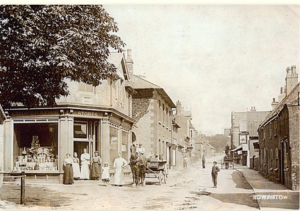
Edwinstowe Cooperative Store with manager & staff. High Street 11th May 1904
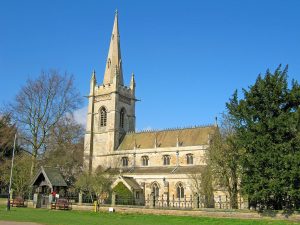 St John’s Church, Perlethorpe. Perlethorpe along with Carburton, an adjoining chapelry, has the oldest parish register in England [1528] and contains entries of births, marriages and deaths.
St John’s Church, Perlethorpe. Perlethorpe along with Carburton, an adjoining chapelry, has the oldest parish register in England [1528] and contains entries of births, marriages and deaths.
St John’s Church, Perlethorpe
4th Earl,Charles William Sydney (1854-1926) & Countess Manvers with their family.
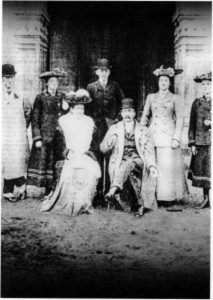 Charles William Sydney, joined the Grenadier Guards in 1872 and served as a Lieutenant until his retirement in 1880. He was also at various times Brigadier-General commanding the North Midlands Infantry Volunteers, Captain of the South Nottinghamshire Yeomanry Cavalry, and an honorary Colonel in the 8th Battalion Sherwood Foresters. He was elected as Conservative M.P. for the Newark division of Nottinghamshire in 1885. The 4th Earl was a keen sportsman and was Master of the Rufford Hunt from 1900.
Charles William Sydney, joined the Grenadier Guards in 1872 and served as a Lieutenant until his retirement in 1880. He was also at various times Brigadier-General commanding the North Midlands Infantry Volunteers, Captain of the South Nottinghamshire Yeomanry Cavalry, and an honorary Colonel in the 8th Battalion Sherwood Foresters. He was elected as Conservative M.P. for the Newark division of Nottinghamshire in 1885. The 4th Earl was a keen sportsman and was Master of the Rufford Hunt from 1900.
4th Earl (1854-1926), & Countess Manvers with their family.

Charles William Sydney Pierrepont, 4th Earl Manvers (1854 – 1926) was Master of the Rufford Hounds. Pictured here with his huntsman outside Thoresby Hall.
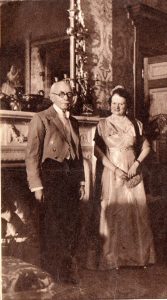
Col. G. J. Walshe and Lady Manvers at Thoresby Hall. Rufford Hunt Ball, 1947
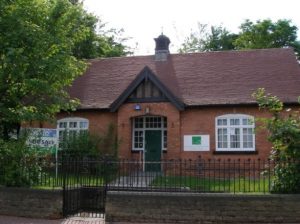

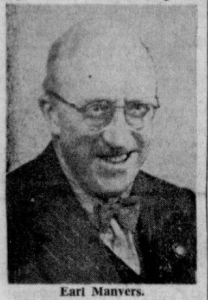 In Edwinstowe the Old Library (now Fables), and St Mary’s Church Rooms. Charles was responsible for the building of the old library and the Church Rooms.
In Edwinstowe the Old Library (now Fables), and St Mary’s Church Rooms. Charles was responsible for the building of the old library and the Church Rooms.
Gervais Evelyn Pierrepont (1881 – 1955) succeeded as 6th Earl Manvers, following the death of his cousin, Evelyn Robert, 5th Earl. Gervais fought in the First World War between 1914 and 1919, where he was mentioned in despatches. A father to 3 children, Evelyn Louis, (1924 – 1928), Lady Mary Helen Venetia Pierrepont (1920 – 1930) and Lady Frederica Rozelle Ridgway Pierrepont (1925 – 2015). Unfortunately, the title became extinct when he died without an heir and the house remained with his wife Countess Manvers and their only surviving child, Lady Rozelle Raynes, who inherited the Manvers estates.
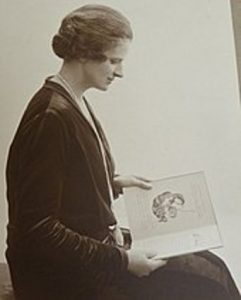 Marie-Louise Roosevelt Pierrepont, Countess Manvers was a talented artist. Her work has hung in national galleries and exhibitions and the Royal Academy in London. Her drawings and paintings of the many places she visited are of historical interest today, and her studies of life on Thoresby Estate during the subsequent war years are also an invaluable and unique record of Thoresby at that time. In 1991, Lady Rozelle converted the Stable Block into an Art Gallery which could celebrate her mother’s work as well as display paintings by new artists.
Marie-Louise Roosevelt Pierrepont, Countess Manvers was a talented artist. Her work has hung in national galleries and exhibitions and the Royal Academy in London. Her drawings and paintings of the many places she visited are of historical interest today, and her studies of life on Thoresby Estate during the subsequent war years are also an invaluable and unique record of Thoresby at that time. In 1991, Lady Rozelle converted the Stable Block into an Art Gallery which could celebrate her mother’s work as well as display paintings by new artists.
Countess Manvers (1889 – 1984).
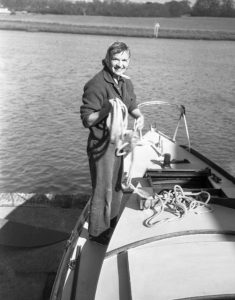 Lady Frederica Rozelle. During the 2nd world war Thoresby Hall was requisitioned by the army, and as Lady Rozelle had no wish to become a debutant, in 1943, aged 18 years, she joined the WRENS. She was appointed stoker on a tug moving men and signals around Combined Ops bases in Portsmouth. Her first marriage ended in divorce, and in 1956 she bought the Martha McGilda and sailed single handedly around the Baltic. In 1965 Lady Rozelle married Dr Richard Raynes. She began a scheme to take disadvantaged teenagers sailing on the Thames, and under the name Rozelle Raynes she wrote several books about her sailing exploits, Rozelle had inherited the Pierrepont estates on the death of her father in 1955.
Lady Frederica Rozelle. During the 2nd world war Thoresby Hall was requisitioned by the army, and as Lady Rozelle had no wish to become a debutant, in 1943, aged 18 years, she joined the WRENS. She was appointed stoker on a tug moving men and signals around Combined Ops bases in Portsmouth. Her first marriage ended in divorce, and in 1956 she bought the Martha McGilda and sailed single handedly around the Baltic. In 1965 Lady Rozelle married Dr Richard Raynes. She began a scheme to take disadvantaged teenagers sailing on the Thames, and under the name Rozelle Raynes she wrote several books about her sailing exploits, Rozelle had inherited the Pierrepont estates on the death of her father in 1955.

Tourist guide to Thoresby Hall.
Tourist Guide to Hall. The Hall was opened to the public in the 1950’s. Sadly, mining subsidence caused damage to the building, which was purchased by the National Coal Board in 1980. Subsequently put on the market, it changed hands several times, before finally becoming an hotel belonging to the Warner Hotel group.
TRAGEDIES
Drowning at Thoresby
In January 1800 a tragic accident occurred in Thoresby Park, as Richard Neil, cordwainer, and John Birdsall, whitesmith, both of Edwinstowe, were crossing the lake in a canoe (although expressly cautioned against it.) It filled and they were unfortunately drowned. Richard Neil left a wife and four young children, John Birdsall was only married on the previous Monday. In 1790, Richard Neil was listed in the Thoresby Disbursements (account books) receiving £20 per year responsible for sailing vessels on the Lake. During 1800 his Lordship continued to pay Richard Neil’s wages to his widow and employed Fanny Birdsall in the kitchens. He also paid a widow’s pension to Sarah Foster who made shoes for the children at Budby school.
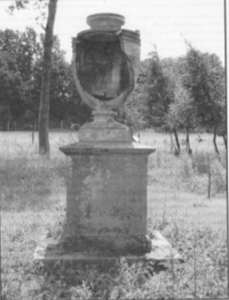
This urn was erected as a tribute to Richard and John and as a caution to others. Further info below.
https://edwinstowehistory.org.uk/local- history/people/families/richard-neil/
Children Drowned at Thoresby
On Monday two children were drowned in Thoresby Park Lake, while attempting to walk across the ice. Sheffield Independent reported 18th December, 1878

In December, 1878 a sad accident occurred on Thoresby lake when two children were drowned while attempting to walk across the ice. Three school girls, named Agnes Sarah Drewitt, 13 years old, Kate Eaton, 11, and Annie Sands, 11, going from Perlethorpe to Budby school, instead of passing along the road went on the ice, sliding forward in the direction of Budby. As they approached the lake-head the ice gave way and they were submerged. Annie was rather behind, and endeavoured to save the other two, and was nearly drowned, but struggled out of the water. The poor terrified girl ran to Budby and gave an alarm. But a boat had to be obtained and drags used, and after a great lapse of time the bodies were lifted out. At the inquest held at Perlethorpe the jury returned a verdict that the deceased were accidentally drowned. Eaton was an orphan and Drewitt was fatherless.
WW2 Plane Crash
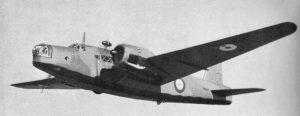
On the 14th/15th of May, 1944 the Vickers Wellington aircraft, HE739 82 OUT RAF Ossington, took part in a Nickel Operation (dropping leaflets over enemy territory) against Rennes. It was one of eight aircraft that took off from RAF Gamston. Seven aircraft completed the mission successfully. On return, aircraft HE739, was circling over Gamston when the port engine failed due to fuel starvation, shortly followed by the starboard one. The aircraft hit the tops of some trees, followed by crashing into more trees and then bursting into flames. It crashed North West of the ‘The Kennels’ on Thoresby Estate, Perlethorpe near Ollerton. Five of the crew were killed and the rear gunner (unknown) was injured.
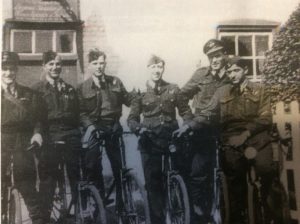
The Crew of 6, taken outside the Robin Hood Public House in Elkesley. Courtesy W Taylor
Further information: https://edwinstowehistory.org.uk/local-history/war-years/second-world-war/edwinstowe-air-crash/

The Kennels, Thoresby Park
MILITARY INVOLVEMENT
Troops stationed on Thoresby Estate in the First World War, 1917.
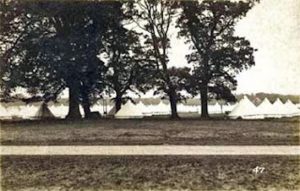
War time. Troops were billeted in the Park during both World War 1 and 2, and used as a training ground for British army tanks during WW2.

Past and present colonels. Thoresby Camp 1913
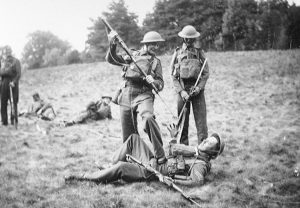
Close quarters combat 1940
Men of the 3rd County of London Yeomanry practise close quarters combat at Thoresby. 1940.

Proteus Camp, Thoresby Park, WWII Army Camp, became a German PoW Camp. In use 1942–2002. The camp was situated in the woods just north of Ollerton roundabout on the A614, from the early 1940s it was used by the British and American armed forces, The site had accommodated up to 1,000 personnel at its peak along with tanks, mechanised vehicles and a small-arms firing range. The site was used by the Ministry of Defence as an Army training camp until October 2004 when it became surplus to requirements and reverted back to the control of the Thoresby Estate
PRESENT DAY

Coat of arms

The Hall
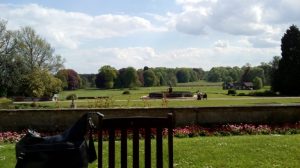
Tea on the Terrace
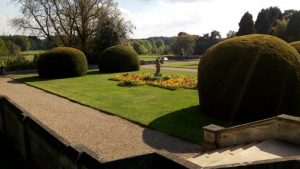
View from terrace
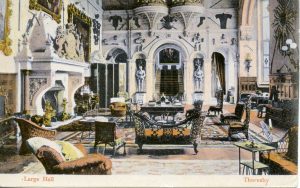
Large Hall
 Detail of Fireplace. Carved by Tudsbury
Detail of Fireplace. Carved by Tudsbury
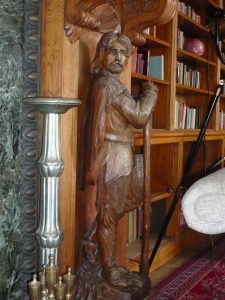

Other carvings by Tudsbury

Entrance to courtyard.
Photo M. Wright

Photo M. Wright
Courtyard museum. The collection focuses on the role of three old and famous local cavalry regiments, over the last 300 years. the Royal Lancers, the Sherwood Rangers Yeomanry and the South Nottinghamshire Hussars. Sadly on 29th October, 2023 thieves gained access to the museum and stole a large quantity of antique military silver, considered to be of historic and sentimental value.

Conqueror
Photo M. Wright
Conqueror tank. One of the heaviest tanks produced in the country, built to counter the Soviet 15-3 series heavy tank during the post second world war era of the cold war.
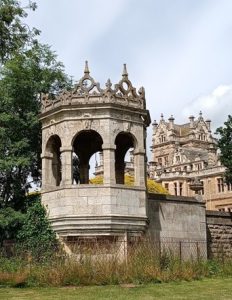
The gazebo forms part of the walled terrace.
Photo M. Wright
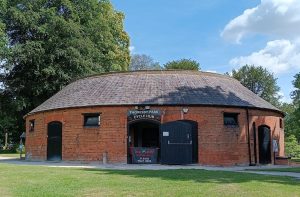 Photo M. Wright
Photo M. Wright
The Round House. Originally the stable block, with bays for 10 horses.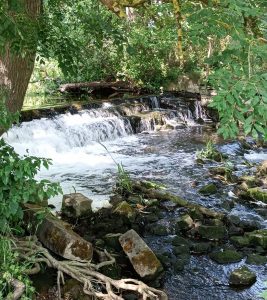 The River Meden which flows through the park. Photo M.Wright
The River Meden which flows through the park. Photo M.Wright
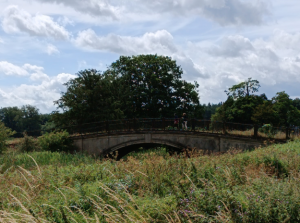
The Green Bridge leading to Perlethorpe village.
Photo M. Wright

Budby Castle, formerly known as Castle William, was built by Eveline, 2nd Duke of Kingston to house crews responsible for the boats on the lake. Named after William Scott, an old naval companion of the Duke’s who died in 1756, and according to the inscription on his grave in Perlethorpe church yard, was “Captain of the Mary”. No doubt he had sailed a boat called “Mary” upon Thoresby Lake.
 The pyramid. Built in 1799 by Charles Herbert, specifically to commemorate Nelson’s victory of the Battle of the Nile.
The pyramid. Built in 1799 by Charles Herbert, specifically to commemorate Nelson’s victory of the Battle of the Nile.
Filming at Thoresby. Thoresby Hall has been a popular location for filmmakers for many years. Its grand architecture, stunning interiors, and picturesque surroundings have made it the perfect backdrop for many movies and TV shows. Such as Great Expectations, Jane Eyre, The Duchess, The Crown, The Black Prince and Journey’s End, to name a few.
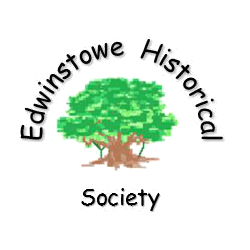 Edwinstowe Historical Society
Edwinstowe Historical Society